The Compostela certificate is the official document that proves you completed a pilgrimage to Santiago. You might think any honest pilgrim who goes to the Pilgrim’s Office will automatically receive it… but no! In fact, getting the Compostela is subject to rather strict conditions, which the Cathedral and its agents take very seriously. Due to ignorance or problems beyond their control, many pilgrims happened to be denied their certificates once they arrived in Santiago. What a disappointment!
So, what can you do to prevent this from happening to you? Well, first, be well-informed about the criteria that make a pilgrim eligible for Compostela. Then, simply respect them!
Let’s go over the requirements to get your Compostela.
In this post
Some reminders
Rule #1: Means of transport and accepted Caminos
Rule #2: Minimal distances
Rule #3: Stamps on the pilgrim’s passport
Rule #4: Purpose of the pilgrimage
Rule #5: Be physically present
Rule #6: Maturity and awareness
Additional rule: Comply with the new registration system
Conditions… that are actually not conditions
Recap
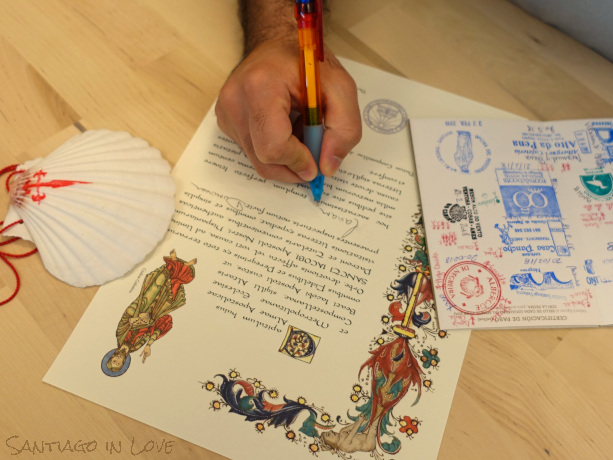
Some reminders
What is the Compostela?
It’s the official document that acknowledges one’s completion of the pilgrimage to Santiago. It’s an individual certificate, free of charge.
Its origins date back to the Middle Ages, when letters of recommendation were issued by the Church to pilgrims, to help them prove they had indeed completed their pilgrimage once they returned home. The need for such document decreased, until it eventually disappeared. The certificate was reborn at the beginning of the 20th century, at the same time as the pilgrimage to Santiago. Only then did it take on the form we know today.
Who grants the Compostela?
Imitations can be found, but they have no value. A real Compostela can only be delivered by the Chapter of the cathedral of Santiago.
Where can you get a Compostela?
At one and only place: the Pilgrim’s Office in Santiago, that represents the cathedral’s Chapter!
Oficina de Acoguida al Peregrino
Pilgrim Welcome Office
🏠 Rúa Carretas, nº33 – 15705 Santiago de Compostela
📞 0034 981 568 846
📧 oficinadelperegrino@catedraldesantiago.es
🔗 Website
Normal opening time: 10am – 6pm
Subject to change!
Open all year
except on January 1st and on December 25th
In short, how does one get it?
Once you completed your pre-registration online, present yourself to the Pilgrim’s Office. There, wait for your number to be called and go to your designated desk.
Give the agent your pilgrim passport and a proof of identity. Check your personal information are right and sign it to finalize your registration. The agent will check your identity, as well as your last stamps and their dates. They will ask you the purpose of your pilgrimage and if you really did ALL the way on foot (or by bike, or on horseback), without cheating. If everything checks out, they will write your name down on your certificate, in Latin.
Here you go, you received your Compostela. Congratulations!
Rule #1: Means of transport et accepted Caminos
Nowadays, people arrive in Santiago in a lot of different ways. But only a few means of transport allow pilgrims to get a Compostela.
This means, be sure to arrive in Santiago on foot, by bike, on horseback or by boat. Pilgrims with a wheelchair (or similar) are also accepted.
Peregrinos: Jose Antonio Gil Martinez -CC BY / Bicigrinos: Alberto Cabrera – CC BY / Cavaliers: Marion, Santiago in Love – CC BY NC SA
Likewise, people can arrive to Santiago from anywhere. But only the pilgrims who finish their pilgrimage through one of the Caminos that are officially recognized by the Cathedral can get a Compostela.
No need to panic, most of those itineraries well known. They are the Caminos Francés, Norte, Primitivo, Inglés, Portugués, Invierno and the Via de la Plata. It’s also possible to receive a Compostela by returning to Santiago via the Camino de Fisterra y Muxia. Pilgrims traveling by boat can also arrive from the Ruta del Mar de Arousa y Rio Ulla.
Rule #2: Minimum distances
The Compostela is granted under the condition you completed a minimum distance, that depends on the means of transport you chose:
(Only those distances are taken into account: as far as the Cathedral is concerned, the rest of your Camino doesn’t entitle you to get a Compostela)
- on foot or on horseback: the last 100 kilometers
- by bike: the last 200 kilometers
- by boat: 100 nautical miles, then finish on foot from the port
- with a wheelchair (or similar): no definite rule, on a case-by-case basis. Consult the Pilgrim’s Office directly!
BEWARE
They really mean the LAST kilometers before Santiago and NOT any other 100 or 200 kilometers along the Camino!
Some itineraries come with additional requirements: check the chart below
Other tings to keep in mind
It’s possible to complete the required distances at once or in several stages spaced in time. In the second case, make sure you stamp your passport correctly! (see rule #3)
What are the required distances, by Camino?
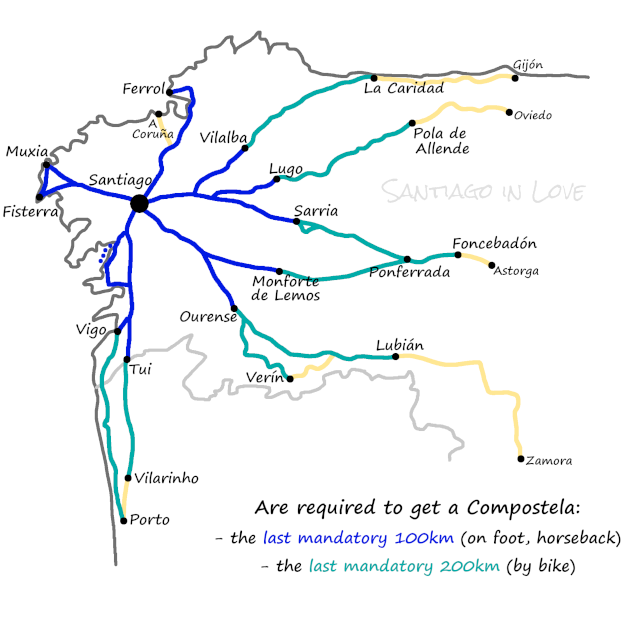
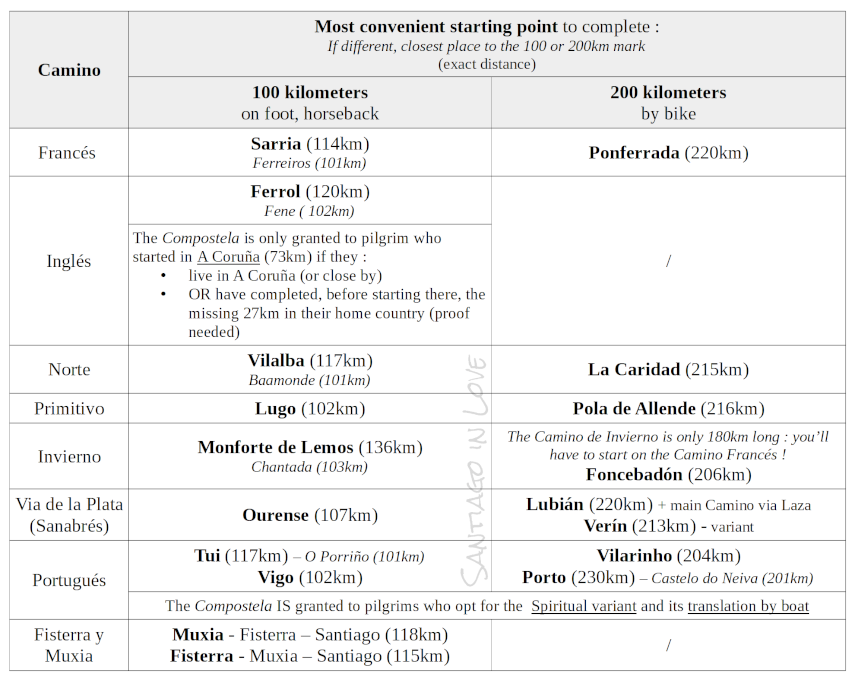
Rule #3: Stamps on the Pilgrim Passport
The Pilgrim Office pays a very close attention to the number of stamps your Pilgrim Passport holds. This is because stamps allow the Office to check your itinerary and make sure you didn’t cheat to reach Santiago. (This method is of course not efficient at all, but that’s a whole other discussion…)
You’re are thus expected to present a Pilgrim Passport:
- that holds a minimum of 2 stamps per day, and their dates: you can have more stamps, but absolutely not less!
- this, for the whole distance that is required of you (100 or 200km, depending on your means of transport)
- stamps can come from any legit source: accommodation, church, restaurant, bar, landmark, etc.

Photo: Santiago in Love – CC BY-SA-NC
Important unspoken things
This is neither officially or clearly stated, but the Office expects to see 4-5 days worth of stamps!
The amount of pilgrims who cheat when they’re only completing the last mandatory kilometers is so important that the Office becomes very suspicious when Pilgrim Passports have less stamps than that. As a consequence, it happens quite frequently that perfectly honest pilgrims have a hard time to get their Compostela when they have, for example, walked their 100km in 2 days (which is pretty frequent for very long distance pilgrims who have been on their Camino for a long while)…
This is particularly true during the high season of the pilgrimage, when there are a lot more turigrinos. The Office is allegedly less strict during the low season (but still, don’t try your luck).
A piece of advice: just have a minimum of 2 stamps for every 25km.
About pilgrimages done in several stages throughout time
Not everyone is luck to complete their pilgrimage in a single go. If you chose to split your last mandatory kilometers in several journeys, be diligent. Stamp and date your Pilgrim Passport correctly.
Stages must follow each other in the right order and chronologically. Stamp your starting point (with the date), then twice a day and at your destination. Stamp at this place again (with the date) when you resume your journey, to show the continuity of your Camino. You’ll have 2 consecutive stamps of the same place, with 2 different dates. Then, continue to stamp your Passport twice a day, and at your destination. Proceed like this until you reach Santiago.
Note: by “place”, I mean “village” or “city”: your consecutive stamps don’t need to be the same (→ from the same accommodation, bar, church) but they need to be from the same village or city.
Rule #4: Purpose of the pilgrimage
Normally, the Compostela is only granted to pilgrims who traveled to Santiago for religious or spiritual reasons.
It makes sense! After all, the Camino is originally a Christian pilgrimage and is, by nature, deeply rooted in this religion. Also, the certificate is delivered by the Cathedral, the appointed keeper of the cult to St James in Santiago. All things considered, it’s actually no surprise that pilgrims are asked about the purpose of their Camino when they come and ask for a Compostela.
Let’s also note that the Latin text on the Compostela is very clearly about the motives that should drive any pilgrim. Here is its translation in English:
“The Chapter of this Holy Apostolic and Metropolitan Cathedral of Compostela, custodian of the seal of the Altar of St. James, to all the Faithful and pilgrims who arrive from anywhere on the Orb of the Earth with an attitude of devotion or because of a vow or promise make a pilgrimage to the Tomb of the Apostle, Our Patron Saint and Protector of Spain, recognizes before all who observe this document that: [name of the pilgrim in Latin] has devotedly visited this most sacred temple with Christian sentiment (pietatis causa). In witness whereof I present this document endorsed with the seal of this same Holy Church.”
If we consider the origins and the purpose of the Compostela, we could even say that the Cathedral is quite generous and liberal by granting it to pilgrims who complete a Camino for spiritual motives rather than strictly religious ones…
Anyhow, pilgrims who completed a Camino with another reason will be granted a non-religious Welcome Certificate instead of a Compostela.
In theory anyways! Some pilgrim have shared that they received a Compostela, even if they specifically asked for a Welcome Certificate…
Rule #5: Be physically present
This rule is back again now that Covid is kind of a thing of past and that the Office welcomes pilgrims again: you must be physically present to receive your Compostela. Unless you’re part of a group, no one can collect it for you. It’s just as impossible to request it by mail, phone or email.
By extension, it also means it’s impossible to get a Compostela by proxy. Many walk the Camino for a cause or in the name of someone else, living or deceased. In this case, the certificate is issued with the name of the pilgrim and a special mention is added, that names the recipient of the pilgrimage (“vicarie pro“, meaning “in the name of” + the name of the person).
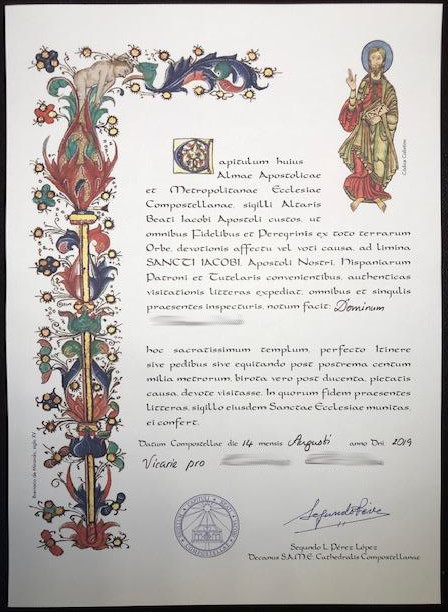
Rule #6: Maturity and awareness
In an effort to safeguard the meaning of the Compostela, the Cathedral decided that it should only be granted to pilgrims who are able to understand the religious or spiritual significance of a pilgrimage. This kind of relates to the rule about a pilgrim’s purpose: one’s intention is important, but it should also be a conscious act.
No problem for adults, the Cathedral assumes they’re capable to make their choices consciously. Kids, on the other hand… This rule directly affect them: babies and young children are added on their parent’s Compostela. Older children are granted a Welcome Certificate instead of a Compostela, unless they received their Communion or show enough maturity.
Another consequence of this rule is that the Cathedral doesn’t give Compostelas to animals. This is because the Catholic Church doesn’t consider they are capable to understand the spiritual engagement a pilgrimage represents.
Because there’s a growing request from pilgrims who travel with their animal companion to get a Compostela at their name, some other organizations offer specific certificate for animal pilgrims. The APACA delivers a credential and a Compostela to cats and dogs. Equum Peregrinans delivers a credential and a Compostela to horses, donkeys and mules.
Additional rule: comply with the new registration system
Here you are, you’ve completed your pilgrimage: congratulations! You just need to get your Compostela. But be warned, you can’t just get it any time or anyhow… In an effort to improve and optimize their welcome for pilgrims and the deliverance of the Compostela (that’s the intent, if anything), the Cathedral set a new system that’s 100% virtual (or almost so).
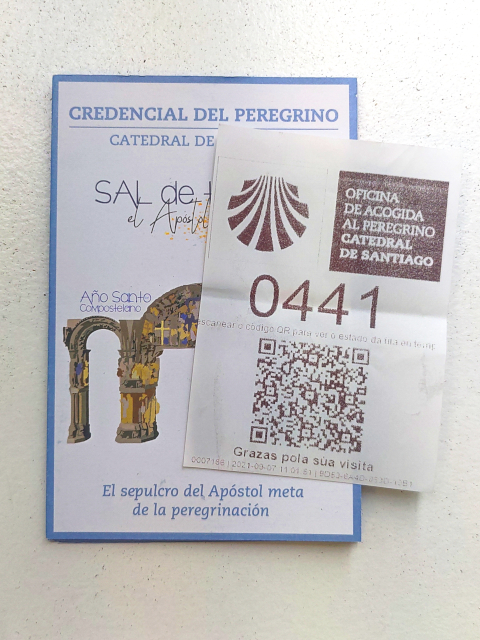
You now must pre-register yourself online, then complete your registration at the Pilgrim’s Office. Pilgrims without a phone or internet access can simply show up at the entrance, where someone will direct them toward someone who will help them register.
Please note this new procedure is mandatory. It allows you to get a spot in the virtual waiting line of pilgrims who are waiting to receive their certificate. Without doing this, no Compostela!
Conditions… that are actually not conditions
ALL the requirements that matter to get a Compostela have been detailed above. Pilgrim sometimes mention other criteria, but those don’t exist! Let’s go through some of them.
To get your Compostela, you DON’T need to:
- be Catholic, or even Christian, or even a believer
- visit the cathedral
- attend Mass, or receive communion
- do additional rituals (prayer, confession, else)
- receive an indulgence
- do a donation
Recap
Voila, you know everything! Let’s just say again that the Compostela is free of charge, personal, with one’s name on it and delivered only to someone who actually completed the pilgrimage to Santiago.
Once more, here are the mandatory requirements to get a Compostela:
- Transport: on foot, horseback, by bike, boat, with a wheelchair (or similar)
- Camino that are recognized by the Cathedral: be aware of specific requirements for the Camino marked by a *
- Caminos Francés, Norte, Primitivo, Inglés*, Portugués, Invierno, Via de la Plata, Camino de Fisterra y Muxia* and Ruta del Mar de Arousa y Rio Ulla
- Distance:
- the last 100km (on foot or horseback)
- the last 200km (by bike)
- 100 nautical miles by boat + end the journey on foot from the port
- Stamps on the Pilgrim Passport: 2 per day (or 2/25km)
- Purpose: religious or spiritual
- otherwise, you will receive a Welcome Certificate
- Be present: you must request your Compostela in person
- another person can’t receive it in your place
- no certificate can be granted by phone or mail
- Awareness: you must be able to understand what a pilgrimage means
- children will receive a Welcome Certificate or their name will be added on their parent’s certificate
- no Compostela can be delivered to animals (other organizations offer a pilgrimage certificate to cats, dogs and horses)
- Mandatory registration system
And you? Were you aware of all these requirements to receive a Compostela?
Did you get one, or another certificate? What was your experience at the Pilgrim’s Office?
Tell us in a comment! 🙂


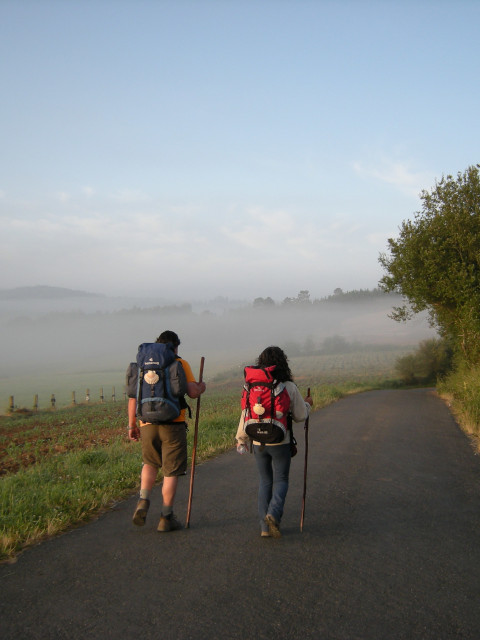
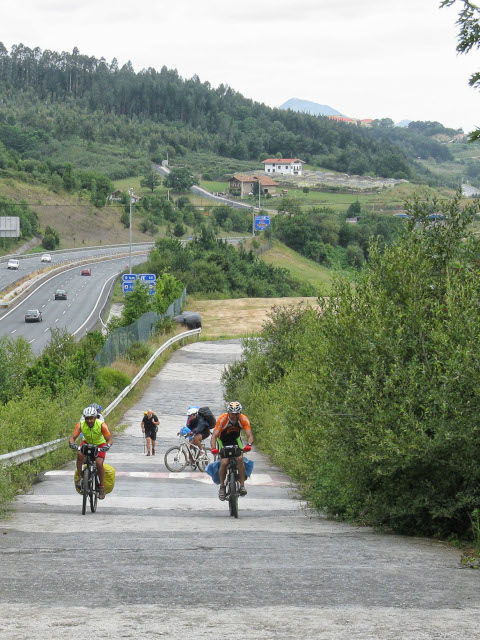
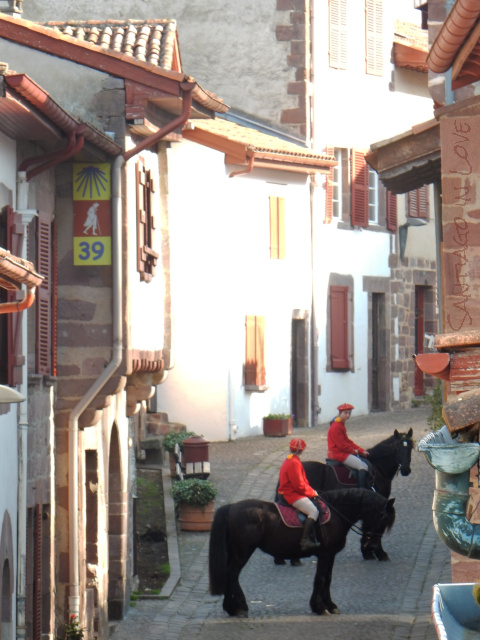

![[2016] Ending of the Jubilee of Mercy on the Camino [2016] Ending of the Jubilee of Mercy on the Camino](https://santiagoinlove.com/en/wp-content/uploads/sites/3/2016/11/Santiago-porte-sainte-fermee-150x150.jpg)


Santiago give to me empowerment!
I love santiago!